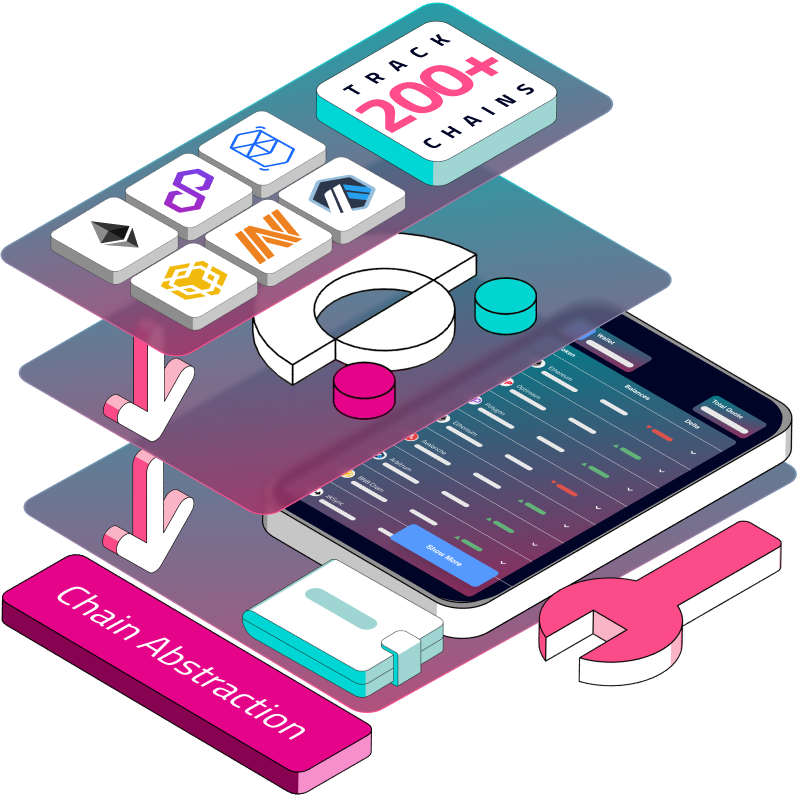What is “Abstraction” in the Context of Web3?
Abstraction in Web3, starting from concepts like account abstraction (ERC-4337) to the emerging trend of chain abstraction, underscores a pivotal shift towards user-friendliness and interoperability in the blockchain ecosystem. The common theme is the simplification of complex processes to enhance usability and accessibility for both users and developers. Account abstraction, for instance, makes wallet management and transaction signing more intuitive, eliminating barriers for non-technical users.
Similarly, chain abstraction, a term popularized by NEAR, seeks to unify the fragmented blockchain landscape, enabling seamless interactions across different networks without users needing to navigate the intricacies of each chain. These movements are crucial as they address two of the most significant hurdles in blockchain's mainstream adoption: complexity and fragmentation. By abstracting away the technical details, Web3 is moving towards a more inclusive and interconnected future, where the focus shifts from the underlying technology to the value and experiences it can deliver.
Understanding Chain Abstraction
Chain abstraction is about simplifying the user and developer experience in the blockchain space by hiding the complexities of interacting with different blockchains. It's like using the internet without needing to know how data moves from one server to another; you just expect it to work seamlessly.
Here are some examples of chain abstraction in action:
Cross-Chain DeFi Platforms: Platforms like ThorChain and AnySwap enable users to swap tokens across different blockchains without having to use separate exchanges or bridges. Users interact with a single interface, and the platform takes care of the underlying cross-chain mechanics.
Unified Wallets: Wallets like MetaMask's Snaps aim to support multiple blockchains, allowing users to manage their assets across different networks in one place. Users can send, receive, and interact with tokens on various chains without switching wallets or networks manually.
Multichain NFT Platforms: Marketplaces such as OpenSea support NFTs from multiple blockchains, allowing users to buy, sell, and view NFTs across different networks through a single platform interface. This removes the need for users to navigate multiple NFT marketplaces specific to each blockchain.
Blockchain Agnostic dApps: Some dApps are being developed to operate on multiple blockchains simultaneously. For example, a gaming platform could allow players to use assets from Ethereum, Binance Smart Chain, and Polygon without worrying about which blockchain those assets are on. The game abstracts away the chain-specific details, focusing instead on gameplay and in-game economics.
Protocol-Level Abstraction: Projects like Cosmos and Polkadot facilitate chain abstraction at the protocol level by enabling different blockchains to interoperate seamlessly. Through their respective inter-blockchain communication protocols, they allow data and assets to move freely between chains, abstracting away the complexity from both developers and users.
Smart Contract Abstraction: Tools like Chainlink's Cross-Chain Interoperability Protocol (CCIP) aim to simplify the development of cross-chain applications by providing a standardized way to create smart contracts that can interact with multiple blockchains. This allows developers to build complex cross-chain logic without dealing with the intricacies of each blockchain.
Why Does Chain Abstraction Matter?
Most people find blockchain and Web3 technology complex because of the technicalities involved, like managing wallets, gas fees, and navigating through different blockchains. Chain abstraction aims to remove these barriers, making it as easy as using a traditional app.
For developers, building dApps (decentralized applications) that can reach a wide audience means tackling these complexities head-on. They need to consider which blockchain to build on, how to handle transactions across chains, and how to manage data from different sources. This can limit the dApp's potential user base to only those familiar with these concepts.
How Covalent Supports Chain Abstraction
Covalent's mission and core product offering are deeply aligned with the ethos of chain abstraction, striving to simplify access to blockchain data and enhance interoperability across the diverse landscape of blockchain technologies. Here's how Covalent embodies the principles of chain abstraction:
Unified API: Covalent offers a unified API that provides a single point of access to data from multiple blockchains. This abstraction layer eliminates the need for developers to interact with each blockchain's unique data structure or learn multiple query languages, significantly simplifying the development process for multi-chain applications.
Cross-Chain Compatibility: By supporting a wide range of blockchains, Covalent enables applications to seamlessly integrate data from various networks. This cross-chain compatibility is a core aspect of chain abstraction, allowing users and developers to experience the blockchain ecosystem as a cohesive whole rather than a collection of isolated silos.
Simplified Data Retrieval: Covalent abstracts away the complexity of directly querying blockchain nodes, indexing data, and handling the intricacies of smart contract interactions. Developers can easily fetch comprehensive blockchain data, including transactions, wallet balances, NFT metadata, and DeFi positions, with simple API calls. This simplification supports the broader goal of making blockchain technologies more accessible and user-friendly.
Enabling Richer DApps: With granular, detailed blockchain data, Covalent empowers developers to build more sophisticated and feature-rich decentralized applications. DApps can leverage detailed blockchain data across chains without the overhead of managing multiple data sources, leading to better user experiences and unlocking new possibilities in app functionality.
Supporting Blockchain Education and Inclusivity: By lowering the technical barriers to entry for developers, Covalent contributes to the broader ethos of inclusivity and education in the blockchain space. Its tools and services make it easier for new developers to enter the ecosystem and for existing developers to expand their applications' reach across multiple blockchains.
Conclusion
In summary, chain abstraction is about making blockchain as invisible and seamless as the internet is today. Covalent contributes to this vision by providing a unified API and tools that simplify accessing and using blockchain data, enabling developers to create applications that are accessible to a broader audience without compromising on the decentralized ethos of Web3.
